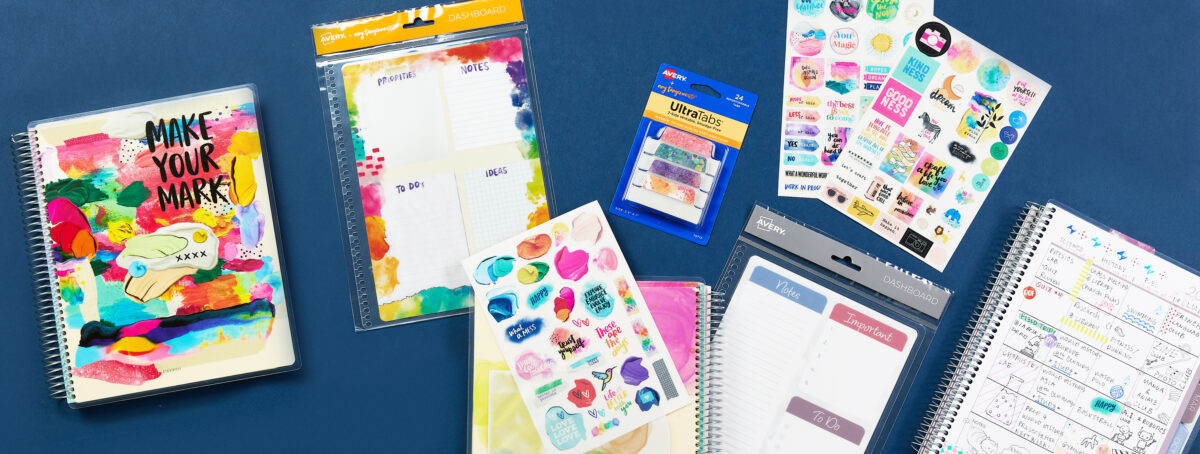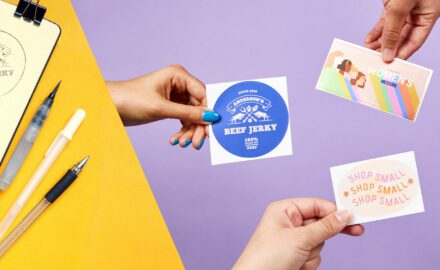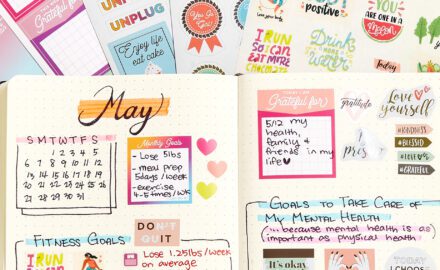What is an academic planner?
An academic planner is a planner or agenda specifically for students. Generally, they cover July through June (as opposed to January through December) in order to align with the school year. While “academic planners” is the most common term, you may also hear them called student planners, school planners, or student agendas interchangeably.
Most importantly, academic planners are excellent tools for teaching students organizational skills that are valuable later in life. Additionally, organizing schoolwork and activities can help students feel less overwhelmed and curb ineffective study habits.
Accordingly, we’ve rounded up the best tips to help students use their planners better. From breaking down different types of academic planners and accessories to answering questions like “What is the best planner for college?” We even have tips for parents to help their kids make the most of their student planners.
You might also like these resources to help you get back-to-school ready:
- The Best Binders for School at Every Age and Level
- 8 Practical Tips for Preparing for Back to School
- Top 5 School Supplies According to Moms
Academic planners vs regular planners
Additionally, academic planners are used in education at all levels, from elementary school to college, and range in complexity accordingly. They are sometimes provided by schools or available through school or college stores. However, regardless of where a student planner is provided or purchased, they all have several common uses. Primarily to track school assignments, record important dates, and set personal goals. Planners for elementary and secondary grades also enhance communication between teachers, students, and parents.

Choices for academic planners
1) Planners dated for the school year
Academic planners, like this one with inspirational quotes and bright colors, are usually preprinted with dates from July through June in order to better align with the average school year. The best academic planners also have plenty of blank pages for notes and goal planning. On top of that, our academic planners also come with free sticker sheets.
2) Custom-printed school planners
If you have more time and a little more budget, order a custom student planner. Custom-order academic planners offer next-level personalization. They’re excellent tools for students because they can be tailored to specific academic needs. Custom Plum Paper planners for students offer custom weekly layouts, personalized cover designs, and an academics section. You can even create a custom academic planner printed with your student’s weekly class schedule and choose from elementary, high school, and college layouts.
3) DIY academic planners
DIY academic planners are generally done in one of two ways. Either by using hole-punched paper and a 3-ring binder or by converting store-bought planners or bullet journals. We will cover both methods in more detail below.
Best academic planners for students
What kind of planner is best for college?
Overall, dated planners with extra sheets are the best ones for college because they’re easy to customize, cheaper than a custom planner, and ready to use quicker than making one from scratch. This particular one (Avery 29874) is our favorite because it also comes with free planner stickers, storage pockets, monthly calendars, horizontal weekly pages, and extra pages for notes. The extra pages even come in a variety of lined, dotted, and grid sheets!
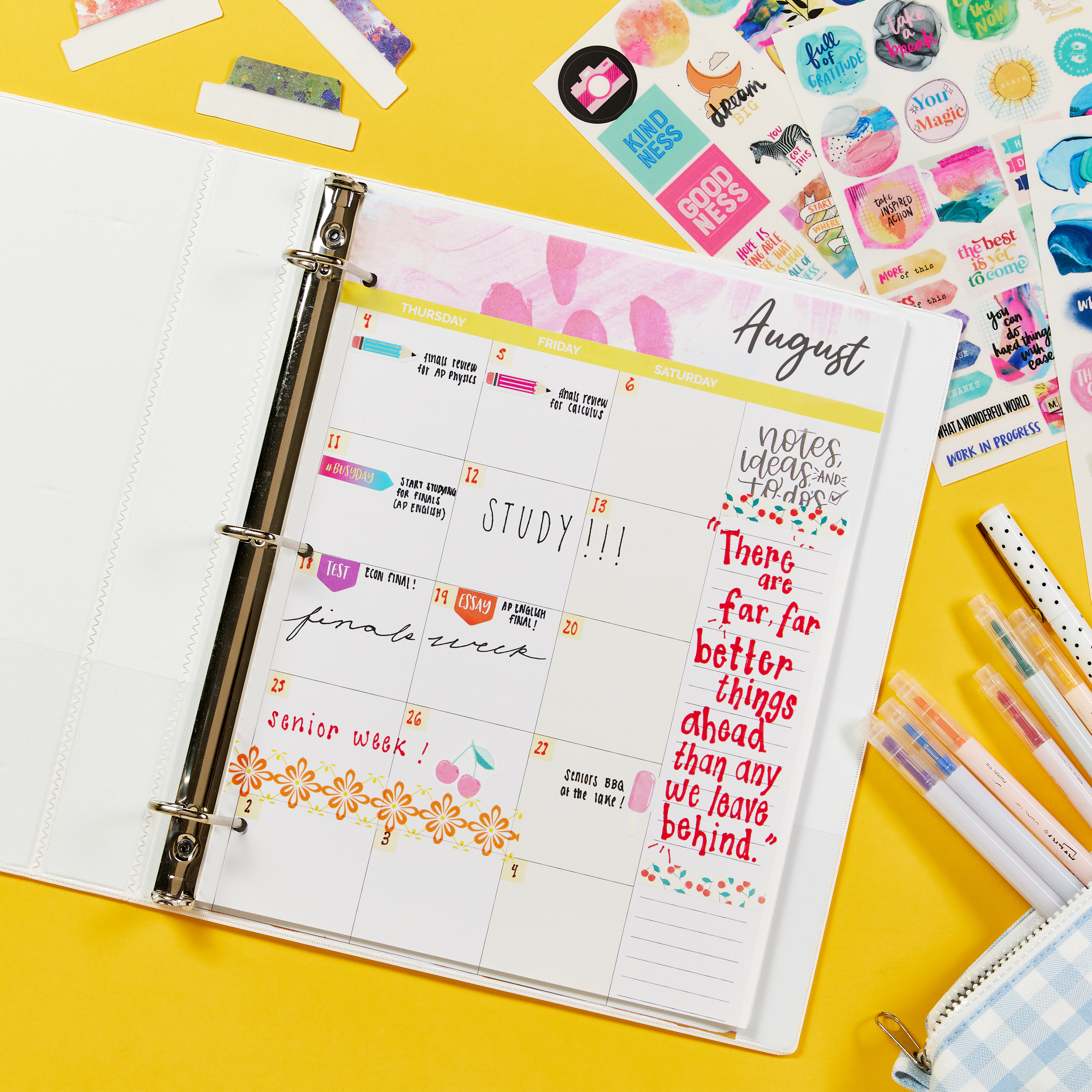
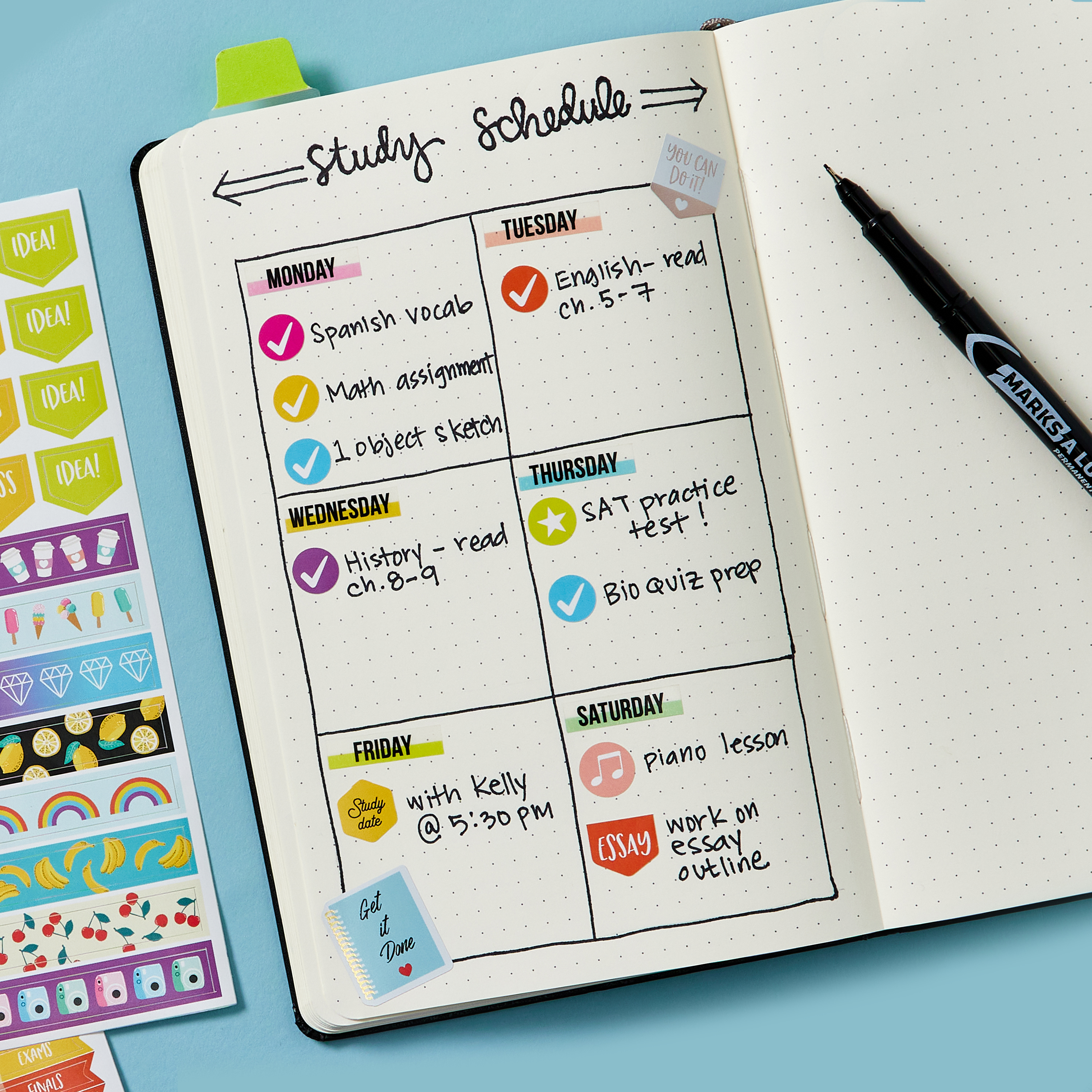
How to make a student planner
Many schools provide students with an academic planner or agenda for keeping track of assignments and important dates. If your kids’ school doesn’t provide one, there are several options at various price points and levels of convenience to consider.
Make a DIY academic planner binder
It is totally possible to make your own academic planner at home with common school supplies. The benefit of going this route is that it’s pretty easy, and it’s likely that you already have the necessary supplies on hand.
First, grab a binder and fill it with 12-tab dividers for the months. If you haven’t decided on what type of binder to use, check out our helpful binder resource page where you can quickly browse different styles and compare features. Then, print and hole-punch simple weekly calendar pages that the kids can fill in as they go. Finally, add paper at the end for notes, drawing, or journaling.
Convert a regular planner or bullet journal
Of course, you can always convert a regular planner or bullet journal for academic use. This is an especially great option if you need to reuse an old planner. In fact, blank labels with TrueBlock® are ideal for printing date covers to modify planner pages because they completely block anything underneath. Even dark ink and images, so your day and date covers look neat, professional, and pleasing to the eye.
How to use an academic planner effectively
Create a routine for daily use
A planner is a tool that works best when used daily, so creating good planning habits now will set your student up for success at school and later in life. Truth be told, learning how to effectively use a planner to meet goals, increase productivity, and improve time management are valuable skills for nearly every career path. Fortunately, there are a few simple things you can do to help your student learn good habits.
First, and most importantly, make using planners part of your family’s daily routine. One way to do that is to set aside “quiet time” for the whole family to relax and plan or journal. Secondly, help your student get into the habit of adding assignment due dates as soon as they receive them. Thirdly, encourage your kids to feel confident about proactively asking teachers for dates if needed.
Encourage decorating and personalizing
As shown above, it’s important to motivate your student to use their academic planner every day, not just once in a while. One way to do this is to help your student decorate and personalize their academic planner so that it’s something they’re proud of and can’t wait to use.
To begin, encourage your student to personalize the cover of their academic planner. Options range from creating a collage, painting it, covering it in stickers, or adding their own drawings. We have a great article filled with free, printable sticker templates to make DIY decals, and you can also order custom die-cut vinyl stickers in minutes with our online printing service.
Fill in important dates
Next, help them gather any paperwork with dates that the school or their teachers have sent home. Ask your student to fill in their academic planner with all the important school and class dates, along with holidays and birthdays of friends and family. Planner stickers are fantastic for flagging and highlighting these important events so that they visually stand out.
Lastly, teach your student how to use backward planning to stay on top of due dates. When your student adds a due date or milestone for an assignment, have them go back a day or week to add a reminder that the date is approaching.
Set personal and academic goals
As we’ve demonstrated in a previous article, planners do indeed help with goals. As a matter of fact, planners and the SMART goal technique work very well together. This is in part because tracking goals keeps them front of mind and makes your progress visible.
SMART is an acronym that stands for Specific, Measurable, Attainable, Relevant, Time-Based. These words describe a framework for setting small goals that keep you motivated and on track towards more long-term goals and plans. Below is a helpful breakdown to help you categorize and decide on goals for the school year.
| Specific | The goal is narrow, so the steps to success are clear. |
| Measurable | There is a quantifiable way to measure success and track progress. |
| Attainable | You can reasonably accomplish the goal. |
| Relevant | The goal aligns with your larger plan and long-term goals. |
| Time-based | There is an end date for the goal. |
Free printable SMART planner stickers
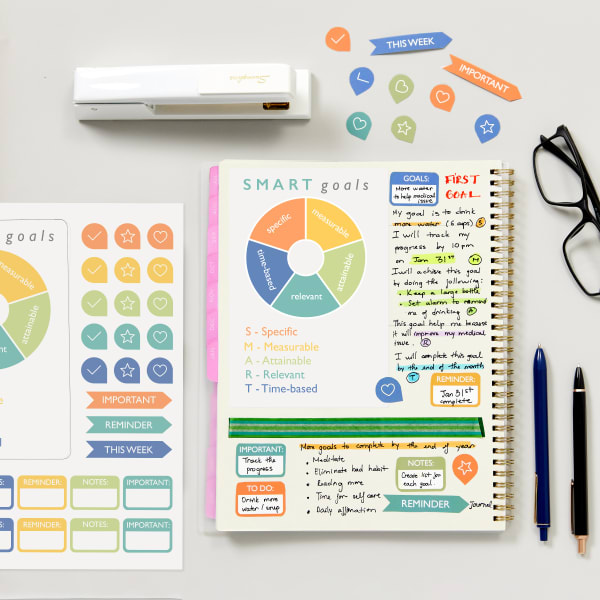
Print this sticker sheet on decal sheet 61512 using a laser or inkjet printer. Or, order the design on a custom-printed Surface Safe® removable label sheet.
For more sticker tips, check out our guide to making DIY planner stickers.
Model how to use an academic planner
As we discussed above, instilling good habits now sets students up for success. So it’s important for parents to use their own planners to model effective time-management practices for their kids. One way you can do this is to use your planner to get organized for back-to-school. This is particularly effective when your kids are still young and want to copy everything mommy or daddy does.
That being so, show your kids your planner and how you use it. Show them the fun stickers you use, like this awesome sticker pack, and how planning helps you be responsible and have time for fun stuff too. Ask them to show you their academic planner and ask them how they think it will help them with school.
Take time to plan together as well. Family “quiet time” is one way to do it. You could also plan collaboratively. For example, everyone has their planner out, and you can help each other add important dates, give suggestions for decorations, etc. However you go about it, modeling how to use a planner teaches by example. And don’t forget the added benefit of staying organized during a very busy time of year!
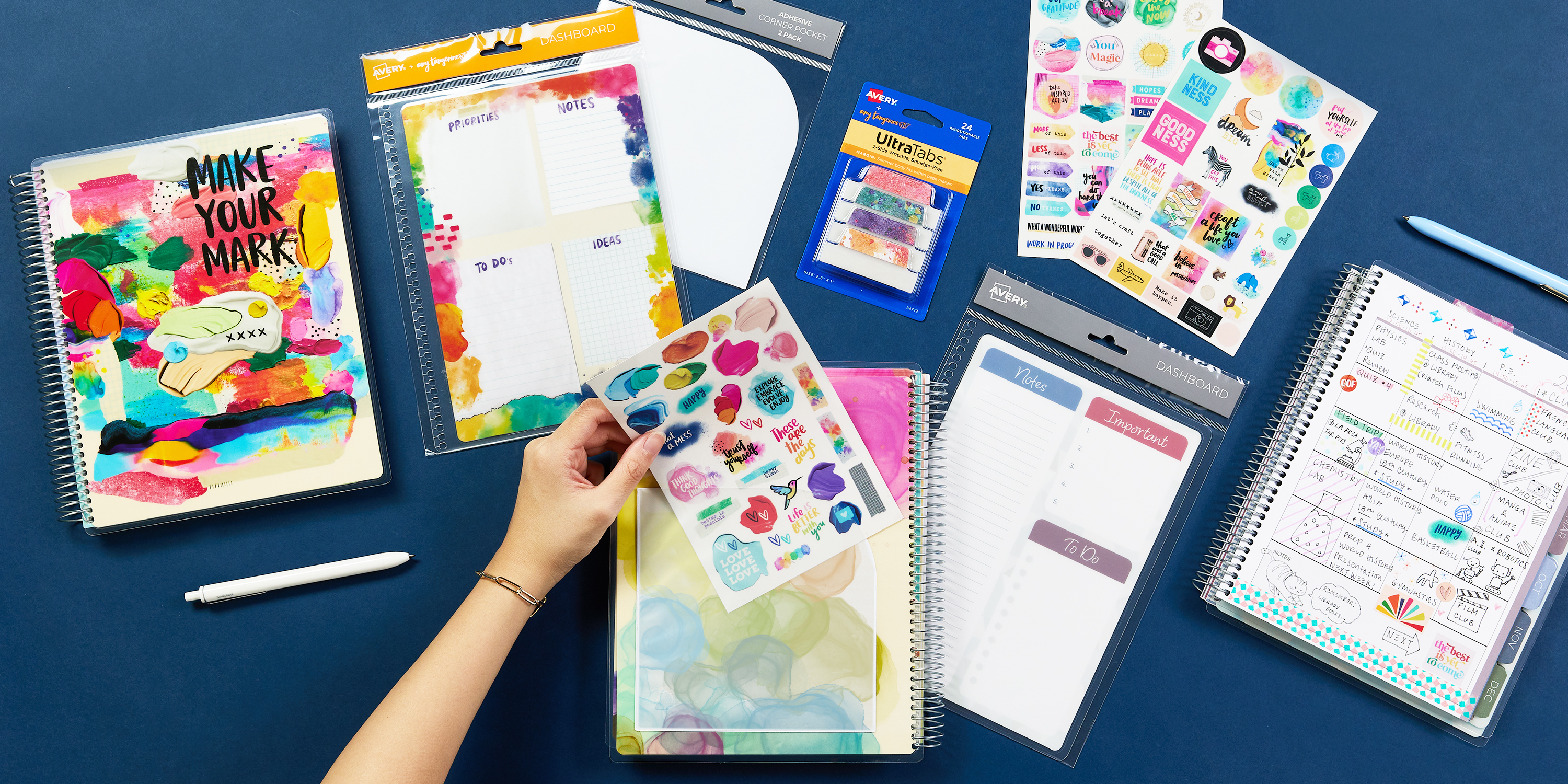
Best accessories for academic planners
The right accessories add a lot of joy, personality, and function to an academic planner. Not only are they fun to use, but there are practical applications too. For example, highlighters add a lot of color to your planner, but they are also indispensable for color-coding and prioritizing. Equally fun yet functional are Avery Ultra Tabs®, which are repositionable index tabs that come in a variety of colors and even sparkly versions! They’re not only stunning to look at, but also super useful for indexing information. Below, we’ll cover a couple more types of our favorite accessories for student planners.
Planner stickers
Next, set up your student with fun stickers. For example, our variety pack for students is perfect for academic planning. Sticker packs are especially great for people new to planning because they make it incredibly easy to jump right in. Or, help your student create their own DIY planner stickers to print at home or have printed for you.
Making your own stickers is a super fun, creative project, and this helpful tutorial to make custom planner stickers makes it easy. Our free online design software stores your saved designs in the cloud, so you can access them from any smart device with an internet connection.
Planner dashboards
Dashboards are plastic pages that snap into spiralbound planners and can be written on with wet or dry erase markers. This is useful for daily to-do lists, reminders, or notes on the go. Easily erasable and reusable, you don’t have to worry about wasting planner pages for jotting down temporary information or working through ideas before committing them to paper. Double-sided dashboards, like these ones, are particularly useful for teacher planners as they offer more room to work.
Planner Tip: We like to pair planner dashboards with our 24495 pen-style dry-erase marker pack in assorted colors. The vibrant colors are nice to look at and great for color-coding, while the slim, pen-style body fits easily in pencil pouches. And, of course, the bullet tips are easier to write with in small spaces than chisel-tip markers.
Corner pockets
Whether you’re student is using their planner for grade school or college, more storage is always welcome! Indeed, adhesive pockets add more storage to any planner, notebook, or binder. Our adhesive corner pockets are perfect for academic planners because they’re made with quality adhesive and materials, just like our labels. Additionally, the corner design is the perfect size for planners and works with a range of small paper or sticker sheet sizes.
Common school supplies
At the end of the day, don’t stress too much because you can definitely leverage the school supplies you have on hand. Colorful highlighters and markers are awesome for planners. If you’re buying new supplies, think about how they can do double duty for school work and planning. Color, in particular, is always something to look for because it makes people feel good. It’s also not a bad idea to learn how to color code like an expert. Not only can color help boost your student’s mood, but it can also help them track information at a glance and organize information better.
Help your student make the most of their academic planner
Planning for the school year is crucial for parents and students. Ultimately, kids need structure and a calm, orderly environment in order to succeed. Learning to use an academic planner not only helps build valuable life skills but also provides structure and order
Of course, shopping for cute planner supplies is a fun bonus that helps you and the kids get excited to plan! What’s your favorite planner tip that you think everyone should try? Connect with us on Instagram or Facebook and let us know!

